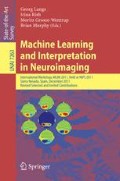Abstract
The goal of many functional Magnetic Resonance Imaging (fMRI) studies is to infer neural activity from hemodynamic signals. Classical fMRI analysis approaches assume a canonical hemodynamic response function (HRF), which is identical in every voxel. Canonical HRFs imply space-time separability. Many studies explored the relevance of non-separable HRFs. These studies were focusing on the relationship between stimuli or electroencephalographic data and fMRI data. It is not clear from these studies whether non-separable spatiotemporal dynamics of fMRI signals contain neural information. This study provides direct empirical evidence that non-separable spatiotemporal deconvolutions of multivariate fMRI time series predict intracortical neural signals better than standard canonical HRF models. Our results demonstrate that there is more neural information in fMRI signals than detected by most analysis methods.
Access this chapter
Tax calculation will be finalised at checkout
Purchases are for personal use only
Preview
Unable to display preview. Download preview PDF.
References
Aguirre, G.K., Zarahn, E., D’Esposito, M.: The variability of human BOLD hemodynamic responses. Neuroimage 8(4), 360–369 (1998)
Berwick, J., Johnston, D., Jones, M., Martindale, J., Martin, C., Kennerley, A.J., Redgrave, P., Mayhew, J.E.W.: Fine detail of neurovascular coupling revealed by spatiotemporal analysis of the hemodynamic response to single whisker stimulation in rat barrel cortex. Journal of Neurophysiology 99(2), 787–798 (2008)
Bießmann, F., Meinecke, F.C., Gretton, A., Rauch, A., Rainer, G., Logothetis, N.K., Müller, K.-R.: Temporal kernel CCA and its application in multimodal neuronal data analysis. Machine Learning Journal 79(1-2), 5–27 (2010)
Blankertz, B., Lemm, S., Treder, M., Haufe, S., Müller, K.-R.: Single-trial analysis and classification of ERP components–a tutorial. Neuroimage 56(2), 814–825 (2011)
Buxton, R.B., Uludag, K., Dubowitz, D.J., Liu, T.T.: Modeling the hemodynamic response to brain activation. Neuroimage 23, 220–233 (2004)
Chu, C., Mourão-Miranda, J., Chiu, Y.-C., Kriegeskorte, N., Tan, G., Ashburner, J.: Utilizing temporal information in fMRI decoding: classifier using kernel regression methods. Neuroimage 58(2), 560–571 (2011)
Devor, A., Ulbert, I., Dunn, A.K., Narayanan, S.N., Jones, S.R., Andermann, M.L., Boas, D.A., Dale, A.M.: Coupling of the cortical hemodynamic response to cortical and thalamic neuronal activity. Proc. Natl. Acad. Sci. USA 102(10), 3822–3827 (2005)
Friston, K.J., Jezzard, P., Turner, R.: Analysis of functional MRI time-series. Human Brain Mapping 1, 153–171 (1994)
Glover, G.H.: Deconvolution of impulse response in event-related bold fMRI. Neuroimage 9(4), 416–429 (1999)
Hardoon, D.R., Mourão-Miranda, J., Brammer, M., Shawe-Taylor, J.: Unsupervised analysis of fMRI data using kernel canonical correlation. Neuroimage 37(4), 1250–1259 (2007)
Haxby, J.V., Gobbini, M., Furey, M., Ishai, A., Schouten, J., Pietrini, P.: Distributed and overlapping representations of faces and objects in ventral temporal cortex. Science 293(5539), 2425 (2001)
Hollander, M., Wolfe, D.: Nonparametric statistical methods. John Wiley & Sons, Inc. (1999)
Hotelling, H.: Relations between two sets of variates. Biometrika 28(3), 321–377 (1936)
Kriegeskorte, N., Goebel, R., Bandettini, P.: Information-based functional brain mapping. Proceedings of the National Academy of Sciences 103(10), 3863 (2006)
Lange, N., Strother, S.C., Anderson, J.R., Nielsen, F.A., Holmes, A.P., Kolenda, T., Savoy, R., Hansen, L.K.: Plurality and resemblance in fMRI data analysis. Neuroimage 10(3 Pt 1), 282–303 (1999)
Leopold, D.A., Murayama, Y., Logothetis, N.K.: Very slow activity fluctuations in monkey visual cortex: Implications for functional brain imaging. Cerebral Cortex, 1–12 (2003)
Logothetis, N.K., Pauls, J., Augath, M.A., Trinath, T., Oeltermann, A.: Neurophysiological investigation of the basis of the fMRI signal. Nature 412(6843), 150–157 (2001)
Lu, Y., Grova, C., Kobayashi, E., Dubeau, F., Gotman, J.: Using voxel-specific hemodynamic response function in EEG-fMRI data analysis: An estimation and detection model. Neuroimage 34(1), 195–203 (2007)
Martindale, J., Mayhew, J., Berwick, J., Jones, M., Martin, C., Johnston, D., Redgrave, P., Zheng, Y.: The hemodynamic impulse response to a single neural event. J. Cereb. Blood Flow Metab. 23(5), 546–555 (2003)
Mourão-Miranda, J., Friston, K.J., Brammer, M.: Dynamic discrimination analysis: a spatial-temporal SVM. Neuroimage 36(1), 88–99 (2007)
Müller, K.-R., Mika, S., Ratsch, G., Tsuda, K., Schölkopf, B.B.: An introduction to kernel-based learning algorithms. IEEE Transactions on Neural Networks 12(2), 181–201 (2001)
Murayama, Y., Bießmann, F., Meinecke, F.C., Müller, K.-R., Augath, M.A., Oeltermann, A., Logothetis, N.K.: Relationship between neural and hemodynamic signals during spontaneous activity studied with temporal kernel CCA. Magnetic Resonance Imaging 28(8), 1095–1103 (2010)
Shmuel, A., Yacoub, E., Chaimow, D., Logothetis, N.K., Ugurbil, K.: Spatio-temporal point-spread function of fMRI signal in human gray matter at 7 tesla. Neuroimage 35(2), 539–552 (2007)
Strang, G.: Introduction to linear algebra. Wellesley-Cambridge Press (2009)
Yacoub, E., Ugurbil, K., Harel, N.: The spatial dependence of the poststimulus undershoot as revealed by high-resolution BOLD- and CBV-weighted fMRI. J. Cereb. Blood Flow Metab. 26(5), 634–644 (2006)
Author information
Authors and Affiliations
Editor information
Editors and Affiliations
Rights and permissions
Copyright information
© 2012 Springer-Verlag Berlin Heidelberg
About this paper
Cite this paper
Bießmann, F., Murayama, Y., Logothetis, N.K., Müller, KR., Meinecke, F.C. (2012). Non-separable Spatiotemporal Brain Hemodynamics Contain Neural Information. In: Langs, G., Rish, I., Grosse-Wentrup, M., Murphy, B. (eds) Machine Learning and Interpretation in Neuroimaging. Lecture Notes in Computer Science(), vol 7263. Springer, Berlin, Heidelberg. https://doi.org/10.1007/978-3-642-34713-9_18
Download citation
DOI: https://doi.org/10.1007/978-3-642-34713-9_18
Publisher Name: Springer, Berlin, Heidelberg
Print ISBN: 978-3-642-34712-2
Online ISBN: 978-3-642-34713-9
eBook Packages: Computer ScienceComputer Science (R0)

